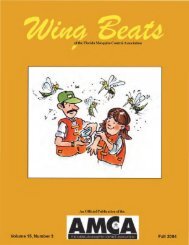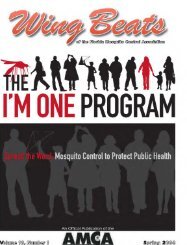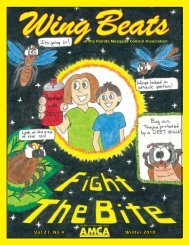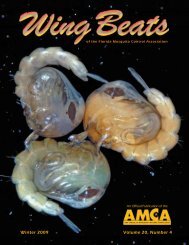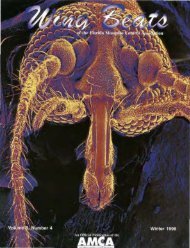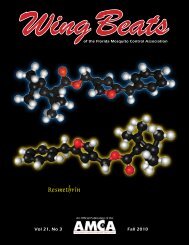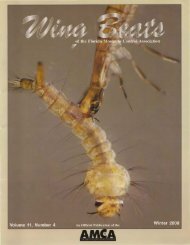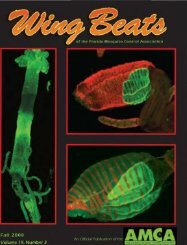losquito Control - Wing Beats - Florida Mosquito Control Association
losquito Control - Wing Beats - Florida Mosquito Control Association
losquito Control - Wing Beats - Florida Mosquito Control Association
Create successful ePaper yourself
Turn your PDF publications into a flip-book with our unique Google optimized e-Paper software.
of the <strong>Florida</strong> :\<strong>losquito</strong> <strong>Control</strong> <strong>Association</strong><br />
{/<br />
An Official Publication of the<br />
Volume 16, Number 1 Spring 2005
On August 13, 2004 Hurricane<br />
Charley, a category 4 storm, devastated<br />
Charlotte County. The<br />
County suffered tremendously,<br />
with 9 out of 1 0 structures sustaining<br />
some form of damage.<br />
The following discussion describes<br />
most severely damaged<br />
structures and problems with the<br />
pieces and parts ofthe structures<br />
that were thrown all over our<br />
county. We can only hope that the<br />
lessons we are learning will help<br />
all of you be better prepared for<br />
any future storm.<br />
In the weeks after the storm, we<br />
have made some discoveries<br />
from both personal and professional<br />
experience. Windows,<br />
screens, roofs, doors, and walls<br />
in most damaged structures were<br />
Figure 3<br />
Daaprs<br />
a Nat1md Disaster<br />
compromised to the point<br />
that rain, from the hurricane<br />
and the normal afternoon<br />
thunder storms, was entering<br />
these structures and<br />
starting to breed mosquitoes<br />
(figure 1 ). My personal experience<br />
was in my own residence.<br />
While salvaging what<br />
we could, it was observed<br />
that every surface that could<br />
hold w ater was breeding<br />
mosquitoes. We started to<br />
look hard at other structures<br />
while at work and found the<br />
same thing was going on all<br />
around the county. It didn't matter<br />
what the surface was; cups,<br />
cabinets, pots and pans, toilets,<br />
tile floors, children's toys<br />
in closets, tubs, washing machines,<br />
dryers, tool boxes in ga-<br />
Figure 1<br />
Figure 2<br />
rages, oil catch cans, and tarps that<br />
were put over computers in homes,<br />
breeding was going on everywhere<br />
(figure 2).<br />
The places most devastated by the<br />
hurricane were mobile home parks.<br />
Some homes were completely gone<br />
while others were damaged to the<br />
point where they could no longer be<br />
inhabited (figure 3). Most of these<br />
homes could not be entered due to<br />
the damage (some of it hidden) to<br />
the floors walls and roofs. It was,<br />
therefore, impossible to get an accurate<br />
account of larva breeding or<br />
to provide barrier treatment. We also<br />
'U'iH-9 r?e
Figure 4<br />
found most mobile homes to<br />
have some sort of storage<br />
sheds that contained items<br />
which can hold water. One<br />
such shed had an old beer<br />
can collection that would<br />
most likely be breeding larvae<br />
with the next rain (figure<br />
4).<br />
In some areas of the county<br />
power could not be restored<br />
to the homes that were damaged.<br />
A lot of these homes<br />
have pools and, with no<br />
power, they cannot function<br />
properly (figure 5). We are<br />
in the process of finding all<br />
ofthe non-functioning pools<br />
(in cooperation with Code Compliance),<br />
and treating them wherever<br />
it is safe to do so. We have<br />
found that 0.51bs. of Altosida pellets<br />
will treat a standard pool for<br />
30 days.<br />
We have also found that a lot of<br />
debris is lying in the woods and<br />
creating another source for mosquitoes<br />
to breed. Examples of<br />
these are: parts of a roof valley<br />
still intact and lying in a way that<br />
it could hold water, rain gutters,<br />
garbage cans, and 5 gallon buckets.<br />
We will have our work cut<br />
out for us come spring rainy season<br />
as this debris will be covered<br />
over by new growth where trees<br />
6 Spring2005<br />
were blown over there are<br />
very large holes in the ground<br />
that are holding water, creating<br />
more potential breeding<br />
sites. It has also been<br />
found that, after the county<br />
stopped curbside pick-up of<br />
storm related debris, illegal<br />
dumping has started to increase<br />
(figure 6).<br />
After taking several samples<br />
back to our lab we found that<br />
Figure 5<br />
we were dealing primarily with<br />
Culex nigripalpus, Cx.<br />
quinqefasciatus, Cx. erraticus<br />
and Aedes a/bopictus. Our main<br />
concern is that Cx. nigripalpus is<br />
a vector of West Nile (WNV) and<br />
St. Louis Encephalitis (SLE) viruses.<br />
With many structures that<br />
were compromised in Hurricane<br />
Charley further damaged by Hurricanes<br />
Frances and Jeanne, we<br />
could be looking at a major health<br />
problem if we cannot get into<br />
Figure 6<br />
these structures<br />
and treat the<br />
breeding or remove<br />
the standing<br />
water. Now<br />
we will be looking<br />
at containerbreeding<br />
species<br />
moving into the<br />
areas where we<br />
used to deal with<br />
just salt marsh<br />
mosquitoes.<br />
As a county we<br />
are now looking<br />
at what we could<br />
do to be better<br />
prepared for an
g<br />
p g
ing <strong>Beats</strong><br />
Spring 2005<br />
19
sample still did not truly represent<br />
the smaller droplet sizes even using<br />
a faster rotational speed and smaller<br />
sampler size. The correction D 2 (n x<br />
d) however produced a Dv 0.5 comparable<br />
to that of the laser systems.<br />
Results from the high pressure<br />
impinger nozzle are presented as<br />
Dv 0.1 , Dv 0.5 , and Dv 0.9. The D 3 again<br />
severely over estimated the droplet<br />
size spectrum again. For both nozzle<br />
systems the D calculation along with<br />
5.6 m/s, 3 mm sampler returned<br />
droplet size distributions very close<br />
to that of the laser measurements<br />
(Table 1). Figure 2 shows the cumulative<br />
volume fraction for the<br />
AU400 and the PJ12 nozzles using<br />
the new sampler.<br />
As mentioned previously the D 3 calculation<br />
for cumulative volume fraction<br />
provided a significant over estimation<br />
of the droplet size distribution.<br />
The new nozzle systems investigated<br />
here produce a much smaller<br />
and narrower spectrum compared to<br />
the old flat fan system. The narrower<br />
spectrum (
RECOGNIZE THE INDIVIDUALS WHO HAVE MADE OUTSTANDING<br />
CONTRIBUTIONS TO MOSQUITO CONTROL:<br />
NOMINATE THEM FOR THE FMCA AWARDS!<br />
Any <strong>Florida</strong> <strong>Mosquito</strong> <strong>Control</strong> <strong>Association</strong> member in good standing may nominate a candidate for any award<br />
by submitting supporting information to the Awards Committee, to include a short biographical sketch of the nominee,<br />
emphasizing those accomplishments deemed worthy of the award. There is no official nomination form. Endorsements<br />
and written support from other colleagues are encouraged.<br />
All submissions will be acknowledged. Nominations must be received by July 29, 2005.<br />
The Maurice W Provost Memorial Award - established as a memorial to the first director of the <strong>Florida</strong> Medical<br />
Entomology Laboratory, honors persons who have made outstanding contributions to mosquito control and/or<br />
biting fly biology in <strong>Florida</strong>. Recipients have been instrumental in developing sound management and operational<br />
methods to reduce pesticide levels and to minimize habitat alteration while reducing mosquito populations; in<br />
increasing our knowledge of mosquitoes and other biting insects and their habitats; and in educating students and<br />
the general public about the importance of various environmental issues facing the citizens in protecting the fauna<br />
and flora in <strong>Florida</strong>.<br />
The Joseph Y Porter Distinguished Achievement Award - recognizes the first president of the <strong>Florida</strong> Anti-<br />
<strong>Mosquito</strong> <strong>Association</strong> and first State health officer of <strong>Florida</strong>, and recognizes scientists who have made significant<br />
contributions to entomology, with special emphasis on the abatement of arthropods of public health importance.<br />
The recipient must have meritoriously contributed to the advancement of entomology research in the field of mosquito<br />
and other biting arthropod control in the State of <strong>Florida</strong>.<br />
The Fred Stutz Memorial Award - honors the former director of Dade County <strong>Mosquito</strong> <strong>Control</strong>, and was intended<br />
to recognize an outstanding contribution to mosquito control by development of procedures that increase effectiveness<br />
in mosquito and other arthropod control, or the design and manufacture of equipment that helped revolutionize<br />
the control of mosquitoes and other arthropods of public health importance. Supporting information should also<br />
include an evaluation and appraisal of the nominee’s accomplishments.<br />
The Sherrie Yarberry Award - was named for a dedicated employee of Jacksonville <strong>Mosquito</strong> <strong>Control</strong>, and was<br />
intended to recognize continued outstanding contributions to operational program activities by veteran, non-administrative<br />
personnel of <strong>Florida</strong> mosquito control related agencies. The recipient must demonstrate exemplary performance<br />
resulting in enhanced unit efficiency or public recognition of excellence of the parent organization. Supporting<br />
information from senior mosquito control administrators and supervisors should include an evaluation and<br />
appraisal of the nominee’s accomplishments.<br />
The FMCA Merit Award - is intended to recognize the outstanding individual contribution to promoting control of<br />
disease-transmitting and pestiferous mosquitoes or other arthropods of public health importance, for scientific<br />
advancement of the discipline, or for developing or extending the public interest in the control of such mosquitoes or<br />
other arthropods. The recipient should represent those characteristics generally associated with responsible leadership,<br />
good citizenship and personal integrity. The recipient need not be a member of the <strong>Association</strong>.<br />
James W Robinson Memorial Award - This award was established in 2005 as a memorial to Jim Robinson,<br />
Director of Pasco County <strong>Mosquito</strong> <strong>Control</strong> District, renown for his innovative development of new equipment and<br />
adoption of new technologies. This award is intended to recognize innovation and ingenuity in optimizing the safe<br />
and efficient operations of <strong>Florida</strong> public health pest control programs. The recipient must have contributed an<br />
outstanding improvement to equipment or techniques used by a non-commercial mosquito control related agency.<br />
This advancement may not be proprietary in nature, and must be freely shared with the <strong>Association</strong>. Supporting<br />
information should include an evaluation and appraisal of the nominee’s accomplishments. The recipient of the<br />
James W Robinson Memorial Award will receive $500 cash, a commemorative certificate, in addition to expenses to<br />
attend the Annual Fall Meeting.<br />
Please submit all inquiries and nomination documents to: Stephen L Sickerman<br />
DACS Bureau of Entomology & Pest <strong>Control</strong>, 3920 Frankford Avenue, Panama City, FL 32405-1953<br />
phone 850-872-4250 ˜ fax 850-872-4271 ˜ e-mail<br />
26 Spring 2005 <strong>Wing</strong> <strong>Beats</strong>
p g



